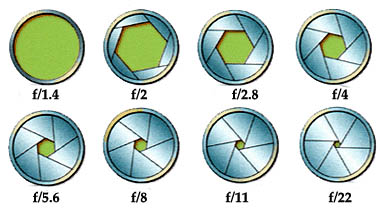1. Diaphragm Aperture.
2. Shutter Speed.
3. ISO.
4. Exposure/Over exposure/Under exposure.
5. Focal Distance.
1. DIAPHRAGM APERTURE .
- It refers to the different position that diaphragm can be set up, more or less open. The diaphragm is a mechanism of the lens that gives the capacity to regulate the amount of light and significantly affects to the final result of the photography.
 |
| 1. Open Diaphragm. 2. Closed Diaphragm. |
- It is measured in "f." values. Smaller values, the diaphragm is more open. Bigger values, the diaphragm in less open. You can see it clearer in the picture.
- It mainly affects to:
1. Amount of light thar sensor receives. If the Diaphragm is more open, more light affects to the sensor, and vice versa. You should keep it in your mind because picture could be gotten too light or too dark.
- 2a. Depth of Field when the diaphragm is very open, (example: f1.4,f3.5,f4.5...) we'll be able to focus in a concrete distance (focal distance) and rest of elements, in front of and behind it, it'll be looked like out-of-focus. It happens because the sensor receives information from "different points of light" at the same time, and due to superimposing several information, it does not look defined.
- 2b. Depth of Field when the diaphragm is very closed, We'll focus all the information, all of the light in a very small aperture, the sensor only receives "one point of light", just one point of information, and that's why we get a defined picture.
Let's see some examples to see it more clearly:
 |
| http://www.atravesdemiespejo.org |
 |
| http://www.verdewasabi.net |
Can you see the difference? With small f values, we get this
out-of-focus effect. Depending on what we want to highlight in the
picture and what general sharpness we want to get, we modify f. values.
+ Portrait pictures, to get full attention over the subject we want to photograph.
 |
| xombit.com |
And for totally defined pictures with big f. values are perfect for landscape and background where we want to preserve as much detail as possible (Look at this beautiful example where you can see clearly also the mountain snow in the background):
 |
| http://luiszapico.com/ |


No hay comentarios:
Publicar un comentario